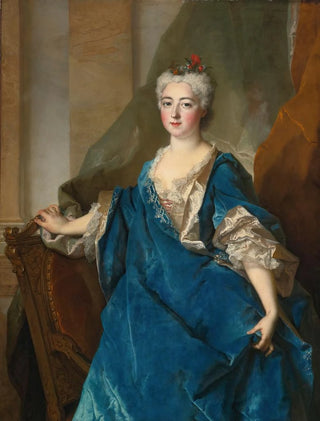Art print | Portrait of Baroness de Besenval - Nicolas de Largillière


View from behind

Frame (optional)
The "Art print of the Baroness de Besenval" by Nicolas de Largillière is an iconic piece that embodies the elegance and refinement of 18th-century French painting. This painting, which beautifully illustrates the art of portraiture, stands out for its attention to detail and its ability to capture the very essence of its subject. The baroness, a figure of Parisian high society, is depicted with unmatched grace, revealing both her beauty and her social status. This art print does more than depict a person; it tells a story, that of an era where art and nobility intertwined to create timeless masterpieces.
Style and uniqueness of the work
Largillière, a master of portraiture, uses a rich and luminous palette to bring his model to life. The delicate colors of the baroness's dress, as well as the softness of her facial features, testify to a mastered technique that combines realism and idealization. The composition is skillfully orchestrated, with a background that highlights the central figure without ever overpowering it. Every detail, from the folds of the dress to the light reflections on the skin, is carefully studied, allowing the viewer to immerse themselves in a universe of sophistication. The work also stands out for its intimate atmosphere, where the baroness seems almost alive, engaging the viewer's gaze with an expression that is both serene and mysterious.
The artist and his influence
Nicolas de Largillière, born in 1656, established himself as one of the greatest portraitists of his time. Trained in the Flemish school, he quickly developed a style that was uniquely his own, blending classical influences with baroque touches. His career was marked by a prestigious clientele, including members of the aristocracy and court. Largillière not only contributed to the rise of portraiture in France but also influenced many contemporary and future artists. His approach, which emphasizes the psychology of the model while incorporating elements of sumptuous decor, paved the way for a new way of conceiving the portrait. Thus, the "Art print of the baroness"

Matte finish

View from behind

Frame (optional)
The "Art print of the Baroness de Besenval" by Nicolas de Largillière is an iconic piece that embodies the elegance and refinement of 18th-century French painting. This painting, which beautifully illustrates the art of portraiture, stands out for its attention to detail and its ability to capture the very essence of its subject. The baroness, a figure of Parisian high society, is depicted with unmatched grace, revealing both her beauty and her social status. This art print does more than depict a person; it tells a story, that of an era where art and nobility intertwined to create timeless masterpieces.
Style and uniqueness of the work
Largillière, a master of portraiture, uses a rich and luminous palette to bring his model to life. The delicate colors of the baroness's dress, as well as the softness of her facial features, testify to a mastered technique that combines realism and idealization. The composition is skillfully orchestrated, with a background that highlights the central figure without ever overpowering it. Every detail, from the folds of the dress to the light reflections on the skin, is carefully studied, allowing the viewer to immerse themselves in a universe of sophistication. The work also stands out for its intimate atmosphere, where the baroness seems almost alive, engaging the viewer's gaze with an expression that is both serene and mysterious.
The artist and his influence
Nicolas de Largillière, born in 1656, established himself as one of the greatest portraitists of his time. Trained in the Flemish school, he quickly developed a style that was uniquely his own, blending classical influences with baroque touches. His career was marked by a prestigious clientele, including members of the aristocracy and court. Largillière not only contributed to the rise of portraiture in France but also influenced many contemporary and future artists. His approach, which emphasizes the psychology of the model while incorporating elements of sumptuous decor, paved the way for a new way of conceiving the portrait. Thus, the "Art print of the baroness"






